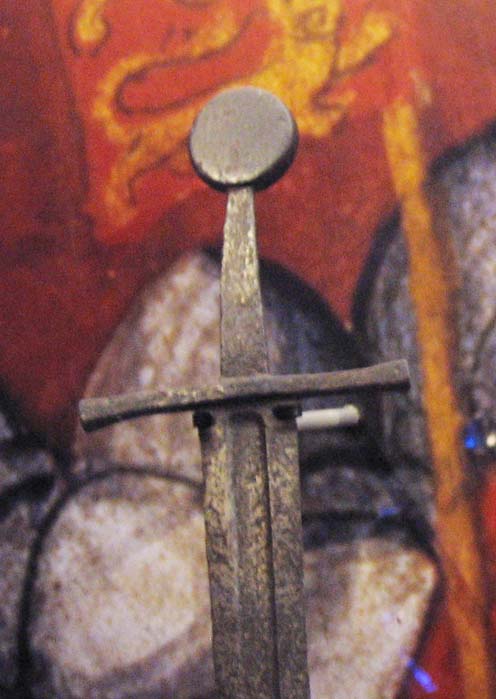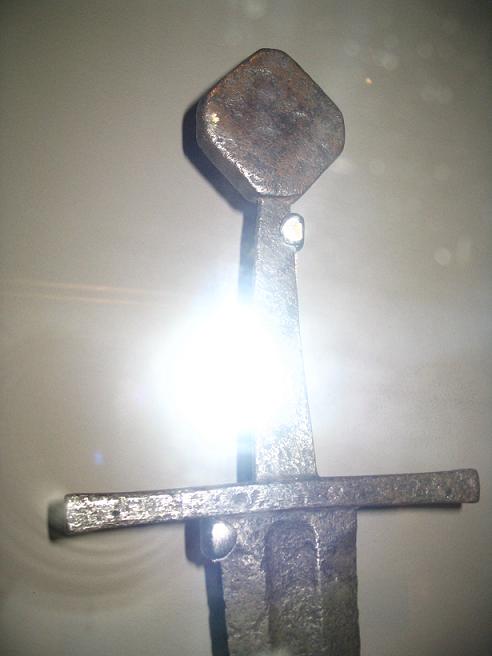| Author |
Message |
|
Jason Elrod
|
 Posted: Thu 28 Oct, 2010 5:54 pm Post subject: Does this fuller terminate before the guard? Posted: Thu 28 Oct, 2010 5:54 pm Post subject: Does this fuller terminate before the guard? |
 |
|
|
I remember it being discussed on this forum that historical, real, antique swords do not have fullers that terminate before the guard. Does this fuller terminate abruptly before the guard? I see no continuation through the tang.
|
|
  |
 |
Chad Arnow
myArmoury Team


|
 Posted: Thu 28 Oct, 2010 6:08 pm Post subject: Re: Does this fuller terminate before the guard? Posted: Thu 28 Oct, 2010 6:08 pm Post subject: Re: Does this fuller terminate before the guard? |
 |
|
| Jason Elrod wrote: | | I remember it being discussed on this forum that historical, real, antique swords do not have fullers that terminate before the guard. Does this fuller terminate abruptly before the guard? I see no continuation through the tang. |
I think the statement should be "that historical, real, antique swords do not usually have fullers that terminate before the guard."  You can probably find some that end before the guard. Keep in mind, though, that a fuller that runs under the guard can terminate under the guard, so you wouldn't necessarily see it on the tang. You can probably find some that end before the guard. Keep in mind, though, that a fuller that runs under the guard can terminate under the guard, so you wouldn't necessarily see it on the tang.
The comment that early terminations on fullers are wrong are almost always made in response to pics of modern-made Viking swords that stop early (see the Hanwei Godfred and new Saxon sword). Or in response to modern-made swords that would typically have fullers that run under the guard but where the maker has expressed a personal liking for them running out beforehand (like some of Tinker's).
Here's a closeup of the sword in question. It does appear to run out on the blade, before the guard. I can't guarantee that the guard is in its original place, though.  I think it's still obvious that this is not the most common arrangement. I think it's still obvious that this is not the most common arrangement.
 Attachment: 49.4 KB Attachment: 49.4 KB


ChadA
http://chadarnow.com/
|
|
    |
 |
Jean Thibodeau

|
 Posted: Thu 28 Oct, 2010 6:32 pm Post subject: Posted: Thu 28 Oct, 2010 6:32 pm Post subject: |
 |
|
Not in this case, but a very wide fuller might be better to end before reaching the tang if the width of fuller is wider than the width of the tang as this would make the transition from blade shoulders to tang a weak one by making the tang thinner than the blade at the shoulders and a weak point where it could easily break or bend.
When the fuller is narrower than the tang it leave a thick ridge on the tang on each side of the fuller running into the tang ( Like an i-beam ) and does not created a weak point t where all bending forces would end up being concentrated.
I'm not saying the above from proof but rather it seems obvious structurally and design wise that if one reduces the thickness of the narrow tang just below the thicker than the tang blade shoulders, it can't be a good thing !
The sword shown may be the exception to the rule in having the tang end before the guard or it may have had a wider/thicker guard originally, or the guard, if it's the original guard, maybe the preserved swords guard is not sitting correctly on the blade shoulders as it would have originally when it had a grip on the tang ?
You can easily give up your freedom. You have to fight hard to get it back!
|
|
  |
 |
|
Jason Elrod
|
 Posted: Thu 28 Oct, 2010 6:45 pm Post subject: Posted: Thu 28 Oct, 2010 6:45 pm Post subject: |
 |
|
Chad, you are right. This isn't the most common arrangement.
I am interested as to why it wasn't a common method of termination in historical swords.
Was it simply that the tools used made it difficult to have a "squared" off fuller?
Is there a functional or dynamic reason to not commonly design a sword like this?
I feel that modern steel allows smiths to consistantly design swords that we feel function properly. However within a historical context, traits such as "squared off fullers" might not have been desireable.
Every one should read Craig Johnson's article on Blade Hardness http://www.myArmoury.com/feature_bladehardness.html to get a better idea of what I'm talking about. In my opinion it is one of the best articles on this website.
Regardless, I also posted this pic because I love swords with unusual features. There are such a vast variation of designs out there that we never get to see.
|
|
  |
 |
|
Stephen Curtin
|
 Posted: Fri 29 Oct, 2010 12:04 am Post subject: Posted: Fri 29 Oct, 2010 12:04 am Post subject: |
 |
|
Just to echo what has been said above, fullers terminating before the guard was not a common feature on historical swords, but it did happen occasionally. I think that there is an example from Nydam mose which has this feature. As for the sword pictured in this thread, It's possible that originally the guard was lower but has come out of place, and slid up the tang with time.
Éirinn go Brách
|
|
   |
 |
|
Timo Nieminen
|
 Posted: Fri 29 Oct, 2010 2:13 am Post subject: Posted: Fri 29 Oct, 2010 2:13 am Post subject: |
 |
|
Fullers terminating before the guard are very common on non-European swords. Lots of Chinese, Indian, and Japanese examples. On historical katanas, fullers often stop before the habaki (the collar on the blade just before the guard). THey also often continue under the habaki, and even along the tang, but this is sometimes a result of the blade having been shortened.
As a converse of the "reproduction sword faults", most cheap modern katanas have fullers that don't stop, that go under the habaki and guard. Easier to do, only need to get one termination right - all sins at the other end are covered up.
"In addition to being efficient, all pole arms were quite nice to look at." - Cherney Berg, A hideous history of weapons, Collier 1963.
|
|
   |
 |
Craig Johnson
Industry Professional

|
 Posted: Fri 29 Oct, 2010 7:11 am Post subject: Good Picture Jason Posted: Fri 29 Oct, 2010 7:11 am Post subject: Good Picture Jason |
 |
|
Thank you for the kind words about my article Jason. Great picture to illustrate the point about swords not being made to just one idea of what they should be. The question "What is a Medieval Sword?" does not have a single answer and in fact if one tries to put a definitive explanation of what it is, you will only limit the idea of the sword.
This is one of the great things that make swords so interesting and one of the difficulties for typologist of the form. That is why they often breakdown a subset as opposed to trying to cover the entirety of swords. When we look at just the idea of what a Medieval sword is, there are large areas of design type and examples that have been very lightly addressed or possibly not even covered in the literature as yet. We have a lot to learn and understand still in this area alone and we live in a time where there are more resources available to the student of the sword than there has ever been. Kind of cool when you think about it 
The sword you pictured is an example of something out of the most common norm but not strange. It also has the small shoulders seen on some swords of this period. I have heard some talk about these as only appearing on modern swords. Probably a function of the shop where the blade was made. How a craftsman works to solve a design question has a lot to do on how these pieces are formed and look.
Best
Craig
Last edited by Craig Johnson on Fri 29 Oct, 2010 7:33 am; edited 1 time in total
|
|
    |
 |
|
Matthew Stagmer
Industry Professional
Location: Maryland, USA Joined: 23 Jan 2008
Posts: 493
|
 Posted: Fri 29 Oct, 2010 7:19 am Post subject: Posted: Fri 29 Oct, 2010 7:19 am Post subject: |
 |
|
I have found quite a few examples of historical broad swords with "stop fullers". Here is another ome quite similar to the example posted.

With this one youc an even see how the edges taper off before the guard. I imagine that if you take a cross section of the should area that it would be a rectangle. This adds so much strength to a sword blade.
I would agree that most examples continue the edge and fuller throught the shoulder, but there are enough examples to say that either is correct. IMO
Matthew Stagmer
Maker of custom and production weaponry
Youtube.com/ThatWorks
|
|
   |
 |
|
|
You cannot post new topics in this forum
You cannot reply to topics in this forum
You cannot edit your posts in this forum
You cannot delete your posts in this forum
You cannot vote in polls in this forum
You cannot attach files in this forum
You can download files in this forum
|
All contents © Copyright 2003-2024 myArmoury.com — All rights reserved
Discussion forums powered by phpBB © The phpBB Group
Switch to the Basic Low-bandwidth Version of the forum
|

